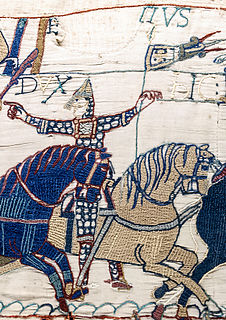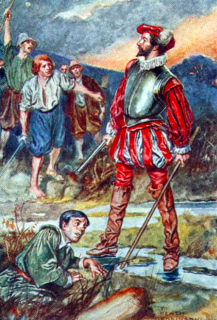Related Research Articles

Baron FitzWalter is an ancient title in the Peerage of England. It was created on 24 June 1295 for Robert FitzWalter. The title was created by writ, which means that it can descend through both male and female lines. His great-grandson, the fourth baron, was an Admiral of the Fleet. The fourth baron's grandson, the sixth baron, died from dysentery at the siege of Harfleur. He was succeeded by his brother, the seventh baron, who was the last known male line descendant of Rollo of Normandy, was succeeded by his daughter and only child, Elizabeth. She was the wife of John Radcliffe. Their son, the ninth baron, was attainted for treason in 1495 with his title forfeited. However, his son Robert Radcliffe obtained a reversal of the attainder by Act of Parliament in 1509 and later served as Lord Lieutenant of Lancashire. He was created Viscount FitzWalter in 1525 and Earl of Sussex in 1529. His grandson, the third earl, was summoned to the House of Lords through a writ of acceleration in 1553 in his father's junior title of Baron FitzWalter. Lord Sussex later served as Lord Deputy of Ireland. He was succeeded by his younger brother, the fourth earl. He had earlier represented Maldon, Hampshire and Portsmouth in the House of Commons and also served as Lord Lieutenant of Hampshire. When he died the titles passed to his only child, the fifth earl. He was Lord Lieutenant of Essex.

Baron Dacre is a title that has been created three times in the Peerage of England, every time by writ.
Baron Kerry is an ancient title in the Peerage of Ireland. It was created circa 1223 for Thomas FitzMaurice, Lord OConnello.

Viscount de Vesci, of Abbeyleix in the Queen's County, now called County Laois, is a title in the Peerage of Ireland. It was created in 1776 for Thomas Vesey, 1st Viscount de Vesci & 2nd Baron Knapton. The title Baron Knapton was created in the Peerage of Ireland in 1750 for the first Viscount's father, John Vesey, 1st Baron Knapton & 2nd Baronet, who had earlier represented Newtownards in the Irish House of Commons. The Baronetcy, of Abbeyleix in the Queen's County, was created in the Baronetage of Ireland on 28 September 1698 for the first Baron's father Reverend Thomas Vesey, Bishop of Killaloe (1713–1714) and Bishop of Ossory (1714–1730).
Viscount Hawarden is a title in the Peerage of Ireland.

Earl of Londonderry is a title that has been created three times in the Peerage of Ireland. The first creation came in 1622 in favour of Thomas Ridgeway, 1st Baron Ridgeway, who served as Treasurer of Ireland and was involved in the colonisation of Ulster. He had already been created a Baronet, of Torrington in the County of Devon, in 1611, Lord Ridgeway, Baron of Gallen-Ridgeway, in the Peerage of Ireland, in 1616, and was made Viscount Gallen-Ridgeway at the same time as he was granted the earldom, also in the Peerage of Ireland. The titles became extinct on the death of his great-grandson, the fourth Earl, in 1714.

Eustace, also rendered Eustis, is the rendition in English of two phonetically similar Greek given names:

Rowland FitzEustace, 1st Baron Portlester was an Irish peer, statesman and judge. He was one of the dominant political figures in late fifteenth-century Ireland, rivalled in influence only by his son-in-law Garret FitzGerald, the "Great" Earl of Kildare.
Earl of Barrymore was a title in the Peerage of Ireland. It was created for David Barry, 6th Viscount Buttevant, in 1627/28. Lord Barrymore held the subsidiary titles of Baron Barry and Viscount Buttevant in the County of Cork in Ireland. After the death of the 8th Earl in 1823, all these titles became extinct.
Events from the year 1549 in Ireland.
Roper is an English surname. In England, people with this surname include members from the House of Roper. Members of the family have held three hereditary titles: Viscount of Baltinglass, Baron Dacre of Glanton, and Baron of Teynham.
Mabel Browne, Countess of Kildare was an English courtier. She was wife of Gerald FitzGerald, 11th Earl of Kildare, Baron of Offaly. She was born into the English Roman Catholic Browne family whose members held prominent positions at the courts of the Tudor sovereigns for three generations. Mabel served as a gentlewoman of Queen Mary I's privy chamber, and enjoyed the Queen's favour.
James FitzEustace of Harristown, 3rd Viscount Baltinglass (1530–1585) James FitzEustace, the eldest son of Rowland Eustace, 2nd Viscount Baltinglass and Joan, daughter of James Butler, 8th Baron Dunboyne. He was born in 1530 and died in Spain in 1585. Baltinglass's family was traditionally associated with the FitzGerald family, the earls of Kildare, but prudently remained loyal to Henry VIII during the "Silken Thomas" Rebellion of 1534–35. For their loyalty they were granted additional lands. Later in the 1540s Thomas FitzEustace, James's grandfather, was created first Viscount Baltinglass by a grateful king. But like many other old English Pale families, the FitzEustaces later became disillusioned.
Roland Eustace, 2nd Viscount Baltinglass of Harristown, County Kildare, Ireland, was born in 1505 and died in 1578. He was the son of Sir Thomas Eustace (1480–1549), 1st Viscount Baltinglass and Margaret Talbot, daughter of Sir Peter Talbot of Malahide Castle, County Dublin.
Thomas Eustace, 1st Viscount Baltinglass was an Anglo-Irish noble who achieved wealth and influence by prudently remaining loyal to the English Crown. He was born circa 1480 at Caslemartin, County Kildare.

Sir Edmund Butler of Cloughgrenan, was an Irish noble and the second son of James Butler, 9th Earl of Ormond and Lady Joan Fitzgerald. He was a scion of the House of Ormond, and a rebel against the Tudors.

Sir Thomas Butler, 1st Baronet of Cloughgrenan (c.1578-1642), was an Irish nobleman, the illegitimate son of Sir Edmund Butler of Cloughgrenan (1534-c.1585) and grandson of James Butler, 9th Earl of Ormond and 2nd Earl of Ossory (c.1496-1546).
Robert Plunkett, 5th Baron Dunsany was an Anglo-Irish nobleman of the Tudor period
Edmond Butler, 3rd/13th Baron Dunboyne (1595–1640) was an Anglo-Irish nobleman of the early seventeenth century. His short life was full of violence and inheritance disputes. His father was murdered when Edmond was a small child, and Edmond as an adult was forced to defend a lengthy lawsuit brought by his uncle, who sought to disinherit him. In 1627 he killed his cousin James Prendergast in a quarrel over a disputed inheritance. For this crime he was tried by his peers for manslaughter, but was acquitted.
Theobald Butler, 1st Viscount Butler of Tulleophelim, was an Irish peer.